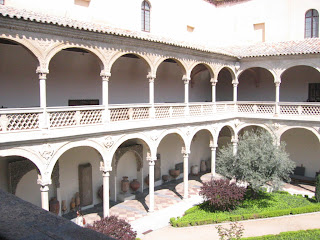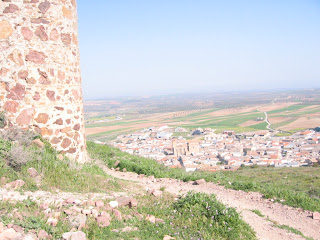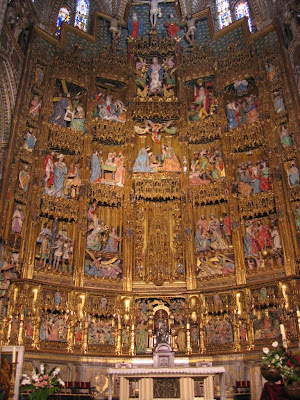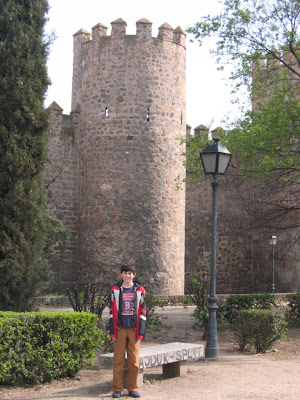Today was a fine touristing day.
Not surprisingly, we all slept like the dead, but Margy and I were pretty happy that we kept the kids up until about 11 so as to adjust to Spanish time.
We also forced everybody out of bed at 9AM, which felt like an appropriate moment on a Sunday morning. The surprise of the morning came at the hotel's breakfast buffet, which included two excellent hams and some excellent sausage.
As museums and the like are only open from 10 to 2, we hustled downtown (well, uptown, up the hill) to the Museo de Santa Cruz.

Normally the home of a large number of El Grecos, along with ceramics and an archaeological museum, it had been taken over by an exhibit of Visigothic Spain.
Now here's a piece of history not well known by us Americans casually familiar with Spanish (or European, for that matter) history. Greatly elided, the Goths came out of the island of Gotland in the Baltic Sea in the early 200's AD, and by 375AD, having migrated down the Vistula river through Russian and the Ukraine, ended up near present day Romania. Under pressure from the Huns, they sought refuge in the Roman Empire which they began by conquering, and ended up being assimilated by. By some time in the middle of the 500's, they had conquered Rome, become Romans (and Christians), and established a kingdom based in Toledo. It was they who brought Christianity to the Iberian peninsula. The Unitarian Universalists among us will be surprised to find out that that they adhered to Arianism, making them our spiritual kindred, and making theirs a non-trinitarian empire.
Most of this came from a video in Spanish only, that I simultaniously translated for the kids. That was harder than I remembered... What I found more interesting was the way the exhibit placed the Visigoths at the origin of Spanish national identity, as the first people to unify present-day Spain. In a town that in some ways still feels steeped in the Spanish Civil War, I found the emphasis in this exhibit on national identity to be intriguing. Also the fact that none of the material was available in any language other than Spanish.

The exhibit at the Santa Cruz museum also highlighted the history of Saint Idelfonso, the patron saint of the Toledo Cathedral, and apparently quite a scholar in his time (early 600's). The
Catholic Encyclopedia tells us that "one day [he was] praying before the relics of Saint Leocadia, when the martyr arose from her tomb and thanked [him] for the devotion he showed towards the Mother of God. ...[O]n another occasion the Blessed Virgin appeared to him in person and presented him with a priestly vestment, to reward him for his zeal in honouring her." We saw endless paintings of him being presented with the vestment, including one by El Greco.
Also at the museum were some beautiful ceramics, many from Portugal, highlighting the unique role of ceramics in Portuguese architecture.


After the Santa Cruz museum, we had intended to go to the Museum of Visigothic history, but we were all Visigothed out. So we walked over the hill to the old Jewish quarter, and had just enough time to see the Sinagoga del Transito, built in the mid 1300's. According to the exhibit, it's one of three synagogues surviving from the expulsion of the Jews under Ferdinand and Isabella. It is now a Sephardic museum (Museo Sefardi), and quite a good (if compact) one.

On the way to lunch, we stopped in at the church of Santo Tome, where the El Greco of the burial of Count Orgaz was painted. Looking like an active church, the painting is in an anteroom to the whole church, and had an excellent (if extensive) audio narration, which only Zac listened to. James Michener couldn't say enough bad things about this painting in his
Iberia, but we appreciated some of the imagery more than he did, and the amazing effects on some of the vestments.
We had walked by a lovely square with a couple of restaurants with outdoor tables, and had a lovely lunch at one. Margy had a great goat cheese salad, and Jordan had bacalao (dried cod fish) with white sauce. It was a thoroughly pleasant lunch in the sun.

Our only agenda item for the afternoon was a visit to Ferdinand and Isabella's church, San Juan de los Reyes, which they built in the middle of the Jewish quarter before they threw out all the Jews, but it was closed for renovation. But we came across the Jesuit church beforehand and went up the bell tower for a great view of the city. We also enjoyed this Renaissance church far more than the others we had seen for its relatively spare decoration and simple lines.

On our way back to the hotel Zac bought himself a copy of Ving Carlos V's sword, for which he had been ferociously comparison shopping, and Margy bought some earrings.
We got back to the hotel at 6, but by 7 we were taking a ring-road tour of Toledo in the car, including some spectacular views of the city across the Rio Tajo, and a turn around the new part of the city where people actually live.
Having eaten a big lunch, we were up for a light meal in a nice place. The bar down the street, recommended by the front desk, looked a little down-market, so we followed our noses to the new part of the city and found one of the few places open - a bar with a dining room and menu. We sat out on the street cafe and had a light supper - very pleasant, if a tad chilly.
Finally, on our way home the churros shop was just closing, but we go their last two churros, just so the kids could try them. We'll work up to fresh churros tomorrow.
The kids are watching Harry Potter on TV (in Spanish), Margy's plotting tomorrow's route to Granada, and I'm blogging. ...
Don't know when the next update is since the apartment in Granada doesn't have WiFi. So absent an Internet Cafe, we'll be checking in from Cordoba on Thursday.








































